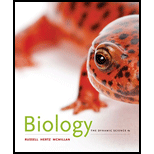
Concept explainers
Introduction:
Biodiversity is defined as the richness of the living systems present at all the levels of
Answer to Problem 1TYK
Correct answer:
The greatest extinction in the history of life on the earth might be occurring now.
Explanation of Solution
Justification for the correct answer:
Option (e) states that ‘the greatest extinction on the earth may be occurring now.’ The biodiversity is now declining rapidly. It is occurring much faster than it might have occurred in the history of the earth. The reasons behind the greatest extinction are threats to the biodiversity. There are three major threats to biodiversity, namely deforestation, over-exploitation of fish population, and alteration of freshwater ecosystems. Hence, option (e) is correct.
Justification for the incorrect answers:
Option (a) states that ‘the greatest extinction on the earth occurred at the end of the Permian period.’ The Permian period ended with a Permian–Triassic extinction event, in which nearly 96% of the marine species and 70% of the terrestrial vertebrates became extinct. The present day extinction is going at a faster pace than the Permian period’s extinction. So, it is an incorrect option.
Option (b) states that ‘the greatest extinction on the earth occurred at the end of the Cretaceous period.’ The Cretaceous period ended with the event of Cretaceous–Paleogene extinction, which led to the non-avian dinosaurs, large marine reptiles, and pterosaurs extinction. It is still not the greatest extinction in the history of the earth. So, it is an incorrect option.
Option (c) states that ‘at the end of the Ordovician period, the greatest extinction occurred on the earth.’ The Ordovician period ended with the Ordovician–Silurian extinction event, which led to the extinction of invertebrates including mollusks and arthropods. This did not end with mass extinction. So, it is an incorrect option.
Option (d) states that ‘the greatest extinction took place at the end of the Cambrian era.’ The Cambrian era ended with the Cambrian–Ordovician extinction event, in which many brachiopods and conodonts got extinct. The greatest extinction did not take place at the end of this era. So, it is an incorrect option.
Hence, options (a), (b), (c), and (d) are incorrect.
Thus, it can be concluded that the greatest extinction might be occurring now and did not take place at the end of the Permian, Cretaceous, Ordovician, and Cambrian era. The current extinction is taking place due to human activities.
Want to see more full solutions like this?
Chapter 55 Solutions
Biology: The Dynamic Science (MindTap Course List)
- Amino Acid Coclow TABle 3' Gly Phe Leu (G) (F) (L) 3- Val (V) Arg (R) Ser (S) Ala (A) Lys (K) CAG G Glu Asp (E) (D) Ser (S) CCCAGUCAGUCAGUCAG 0204 C U A G C Asn (N) G 4 A AGU C GU (5) AC C UGA A G5 C CUGACUGACUGACUGAC Thr (T) Met (M) lle £€ (1) U 4 G Tyr Σε (Y) U Cys (C) C A G Trp (W) 3' U C A Leu בוט His Pro (P) ££ (H) Gin (Q) Arg 흐름 (R) (L) Start Stop 8. Transcription and Translation Practice: (Video 10-1 and 10-2) A. Below is the sense strand of a DNA gene. Using the sense strand, create the antisense DNA strand and label the 5' and 3' ends. B. Use the antisense strand that you create in part A as a template to create the mRNA transcript of the gene and label the 5' and 3' ends. C. Translate the mRNA you produced in part B into the polypeptide sequence making sure to follow all the rules of translation. 5'-AGCATGACTAATAGTTGTTGAGCTGTC-3' (sense strand) 4arrow_forwardWhat is the structure and function of Eukaryotic cells, including their organelles? How are Eukaryotic cells different than Prokaryotic cells, in terms of evolution which form of the cell might have came first? How do Eukaryotic cells become malignant (cancerous)?arrow_forwardWhat are the roles of DNA and proteins inside of the cell? What are the building blocks or molecular components of the DNA and proteins? How are proteins produced within the cell? What connection is there between DNA, proteins, and the cell cycle? What is the relationship between DNA, proteins, and Cancer?arrow_forward
- please fill in the empty sports, thank you!arrow_forwardIn one paragraph show how atoms and they're structure are related to the structure of dna and proteins. Talk about what atoms are. what they're made of, why chemical bonding is important to DNA?arrow_forwardWhat are the structure and properties of atoms and chemical bonds (especially how they relate to DNA and proteins).arrow_forward
- The Sentinel Cell: Nature’s Answer to Cancer?arrow_forwardMolecular Biology Question You are working to characterize a novel protein in mice. Analysis shows that high levels of the primary transcript that codes for this protein are found in tissue from the brain, muscle, liver, and pancreas. However, an antibody that recognizes the C-terminal portion of the protein indicates that the protein is present in brain, muscle, and liver, but not in the pancreas. What is the most likely explanation for this result?arrow_forwardMolecular Biology Explain/discuss how “slow stop” and “quick/fast stop” mutants wereused to identify different protein involved in DNA replication in E. coli.arrow_forward

 Biology (MindTap Course List)BiologyISBN:9781337392938Author:Eldra Solomon, Charles Martin, Diana W. Martin, Linda R. BergPublisher:Cengage Learning
Biology (MindTap Course List)BiologyISBN:9781337392938Author:Eldra Solomon, Charles Martin, Diana W. Martin, Linda R. BergPublisher:Cengage Learning Biology: The Dynamic Science (MindTap Course List)BiologyISBN:9781305389892Author:Peter J. Russell, Paul E. Hertz, Beverly McMillanPublisher:Cengage Learning
Biology: The Dynamic Science (MindTap Course List)BiologyISBN:9781305389892Author:Peter J. Russell, Paul E. Hertz, Beverly McMillanPublisher:Cengage Learning Concepts of BiologyBiologyISBN:9781938168116Author:Samantha Fowler, Rebecca Roush, James WisePublisher:OpenStax College
Concepts of BiologyBiologyISBN:9781938168116Author:Samantha Fowler, Rebecca Roush, James WisePublisher:OpenStax College Biology Today and Tomorrow without Physiology (Mi...BiologyISBN:9781305117396Author:Cecie Starr, Christine Evers, Lisa StarrPublisher:Cengage Learning
Biology Today and Tomorrow without Physiology (Mi...BiologyISBN:9781305117396Author:Cecie Starr, Christine Evers, Lisa StarrPublisher:Cengage Learning Human Biology (MindTap Course List)BiologyISBN:9781305112100Author:Cecie Starr, Beverly McMillanPublisher:Cengage Learning
Human Biology (MindTap Course List)BiologyISBN:9781305112100Author:Cecie Starr, Beverly McMillanPublisher:Cengage Learning





